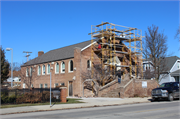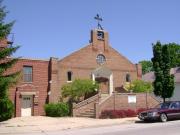Property Record
6626 W Beloit Rd
Architecture and History Inventory
| Historic Name: | Our Lady of Mt. Carmel Catholic Church |
|---|---|
| Other Name: | Living Waters Christian Church |
| Contributing: | |
| Reference Number: | 144646 |
| Location (Address): | 6626 W Beloit Rd |
|---|---|
| County: | Milwaukee |
| City: | West Allis |
| Township/Village: | |
| Unincorporated Community: | |
| Town: | |
| Range: | |
| Direction: | |
| Section: | |
| Quarter Section: | |
| Quarter/Quarter Section: |
| Year Built: | 1939 |
|---|---|
| Additions: | |
| Survey Date: | 20072019 |
| Historic Use: | house of worship |
| Architectural Style: | Romanesque Revival |
| Structural System: | |
| Wall Material: | Brick |
| Architect: | |
| Other Buildings On Site: | |
| Demolished?: | No |
| Demolished Date: |
| National/State Register Listing Name: | Not listed |
|---|---|
| National Register Listing Date: | |
| State Register Listing Date: |
| Additional Information: | This complex is comprised of the three following buildings: Our Lady of Mt. Carmel Church (1938-39, 6626 W. Beloit Road); the Sisters of Charity of St. Joan Antida Convent (1940, 6640 W. Beloit Road); and the Sisters of Charity of St. Joan Antida Home for the Aged (1948, 6670 W. Beloit Road). Beginning with the church, which is located at the easternmost end of the complex, the front-gabled, brick-faced, Romanesque Revival-influenced structure rests on a raised basement and is fronted by a walled staircase. The central, double-door entrance is set within a slightly projecting, stone surround; a single, round-arched window rests at either side of the doorway. Above the entry is a small rose window with modest tracery; a row of soldier brick separates the first level from the peak area. Brick pilasters with stone trim outline the primary facade on either side and additional short pilasters at the peak form a small belltower area which is surmounted by a stylized cross. The visible easterly side wall is divided into three bays by simple, brick, stone-capped piers; each of which carries rectilinear, double-hung windows along the basement level, while the main level features round-arched windows. Adjacent to the church to the west is the 1940 convent, which rises two stories and is also sheathed with brick. The double-door entrance is located at the center of the symmetrically arranged facade and is topped by a transom and set within a simple stone surround. A flat, copper overhangs tops the entry, while a single window rests above, as does a stone inset that is inscribed with "INSTITUTION ST. JOAN ANTIDE." Brick, pier-like ornamentation frames the central bay and terminates in a gabled parapet. Rectangular, multiple-light windows line both the first and second levels, while simple brickwork and stone coping completes the wall's upper edge. Finally, the westernmost structure (1948) rises three stories and is also symmetrically arranged. A central entrance bay is trimmed with stone and is topped by a flat-roof overhang. A stone cross is incorporated into the entrance bay trim. The outermost edges of the structure display tall and narrow sections of glass block, while the remainder carries paired and singly arranged, rectangular sash windows. Established in the early 1930s, the Our Lady of Mt. Carmel Society was formed by a group of West Allis Catholic Italians, led by Mr. Guiseppe LaBarbera. Guiseppe “Thomas” LaBarbera and his brother Subapeno “Vincent” LaBarbera built the church without architectural plans, from their knowledge and experience brought with them from Palermo, Sicily. There was an orphanage next to or part of the convent. This Italian-speaking group petitioned the Archbishop to establish a church for their approximately 250 members. Although the Archbishop concluded that the group could not support the construction of their own church, he did grant permission for the group to pursue rented quarters. For one year, they occupied a storefront on 63rd & Lapham streets; and, for the next few years they met at Holy Assumption Church at 7101 W. Orchard Street. Unbeknownst to the Archbishop, the group began gathering funds for the erection of a church and, in 1938, the subject site on W. Beloit Road was purchased and construction began, again, unbeknownst to the Archbishop. Prior to completion, the Archbishop learned of the progress through the newspaper and meetings were held thereafter in order to address the congregation's breaking of Cannon Law. It was decided that the church would be turned over to the Archdiocese and the congregants would be responsible for the remaining $18,000 in debt. A priest would be sent when the church was completed and the Sisters of St. Joan Antida were asked to provide religious education for the children. The first service was held on 21 September 1939 and in October 1946, the church was designated as a mission to St. Rita's parish in Milwaukee (not West Allis). In 1940, the convent, designed by Herbst & Kuenzli, was built southwest of the church and, eight years later, the Home for the Aged was completed adjacent to the convent. In the early- to mid-1990s, the Sisters retired from teaching religious education and lay persons took over. In 1996, the church was considered for closure and, at the same time, the Sisters of Charity had announced that they were leaving the health care field. Final church services were held on 12 July 1998. The church building is now owned by Living Waters Christian Church, while the former convent and retirement home now serves as a group care home. 2019: Resurveyed - altered appearance due to removal of adjacent buildings in complex (AHI #144647 and AHI #144648). Primary elevation was also clad in scaffolding at the time of survey. This front-gabled brick church was constructed in 1939.6 The primary entrance is centered on the façade and accessed by a set of brick steps. A pair of double board and batten doors is framed by a prow roof entryway. The words DOMUS is centered on stained glass windows in each door. A small circular window opening with keystones in the cardinal directions is located directly above the entrance and features decorative tracery. A decorative bell and cross sit atop a brick steeple. The side elevations are buttressed by stepped brick pilasters with stone caps. The first story hasevenly spaced six-over-one sash windows and the upper story has round arched openings with replacement windows. The facade was obstructed by scaffolding at the time of survey. It appears the brick was being repointed. Originally the Our Lady of Mt. Carmel Catholic Church, this was the first building constructed in a larger religious complex that included the Sisters of St. Joan Antide Convent (AHI #144647), constructed in 1940, and the Sisters of St. Joan Antide Home for the Aged (AHI #144648), constructed in 1948. The complex was organized by the Our Lady of Mt. Carmel Society, a group of Catholic Italians in West Allis that formed in the early 1930s. The complex remained in operation until the 1990s, when the Sisters retired and sold the buildings to a non-profit organization, who then operated the convent and home for the aged as low income housing for the handicapped. The church building was purchased by Living Waters Christian Church in the late 1990s and is currently a nondenominational church called New Vintage Christian Church. The other two buildings were demolished in 2012 by the City of West Allis to make way for the construction of a new 50-unit apartment building for low-income housing for the mentally handicapped (A) |
|---|---|
| Bibliographic References: | Building Permits, 18 August 1938 ($7000 addition). "History of Our Lady of Mt. Carmel Church: Diamond Jubilee Edition," Anniversary booklet prepared by the congregation, 1998, Booklet on file in the Miscellaneous Catholic Churches Binder, Located at the WAHS. There does not appear to be an original permit on file for 6626 W. Beloit Road as the permit on file cites an addition and the cost at only $7,000 and the church cost/debt was cited as $38,000, Permit (for addition), dated 18 August 1938, no architect noted; 2019 (A) Heritage Research, Ltd.; Patrick Schloss, “6640 and 6700 W. Beloit Road,” Nomination Questionnaire, on file at the Wisconsin Historical Society. |
| Wisconsin Architecture and History Inventory, State Historic Preservation Office, Wisconsin Historical Society, Madison, Wisconsin |





